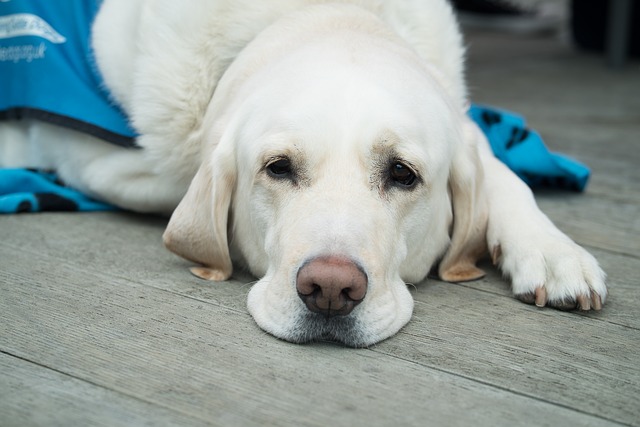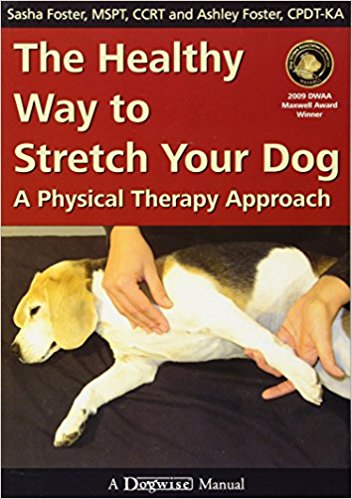Written by Susan E. Davis, PT
The question: “Wow, can I really do Physical Therapy on my own Pet?”
The answer: “Yes, with some help from a sound professional resource, you can!”
Let’s put things in perspective and use some probable scenarios. Your dog went outside to do his ‘business’ in the backyard just as the rain ended.

He ran around happily, sliding and turning, when suddenly you heard a yelp and he came back into the house holding one of the hind limbs off the ground, walking on 3 legs.
You went to the veterinarian the next morning and were told your dog tore his cruciate ligament and needs surgery.
The surgery was done 3 days later. After keeping your dog on activity restriction for 10 days you returned to the veterinarian to have the stitches removed and were advised to have your dog start physical therapy and rehabilitation.
More from the Homestead Guru:
- New Study: Women Sleep Better With A Dog in the Bed(Opens in a new browser tab)
- 10 Reasons Dogs are Good for Your Health(Opens in a new browser tab)
- New Study: Women Live Longer When They Live in Nature(Opens in a new browser tab)
You’re not sure whether this is really necessary but just for the heck of it, you go online to find a service. Well, there is one but its 50 miles away and your dog weighs 80 pounds and is reluctant to get in the car. Oh well, maybe you’ll just go without and see how it goes.
Two weeks later your dog is still walking on three legs. This concerns you because you’ve heard that there is a 70% chance the other side will tear, especially if all of the weight continues to be borne on it. Now what?
Or there’s this scenario: your cat is 12 years old and has started to look disheveled, and is having trouble jumping onto her favorite window ledge.
You go to the veterinarian and radiographs are taken. The doctor explains that your cat has arthritis in the hips, knees and elbows preventing her from moving comfortably and causing self-grooming to be painful.
Acupuncture and Physical Therapy are recommended.
You locate a service providing both but the hours are only in the daytime and you work full-time and are free only in the evening. Besides, your spouse has recently been laid off and the extra expense of acupuncture or Physical Therapy just isn’t in the budget right now.
Without a doubt, there is great need for Physical Therapy and Rehabilitation to help our pets. Ten years ago, few knew these types of services were available for injured or disabled pets, but now it is widely known.
I wrote my first book to help owners navigate the waters of therapeutic treatment and the processes involved, so that the optimal health outcome might be achieved. Several years later it became obvious that the demand for such service far exceeded the supply of qualified professionals. Now what?
Can I teach pet owners to be Pet Physical Therapists? No, but I can guide them in the performance and use of basic techniques that will be helpful!
Let us back up for a minute and establish important groundwork. The Veterinarian must always be consulted first.
Pet Physical Therapy is not a substitute for primary or specialty care provided by your veterinarian. Have your vet determine a diagnosis and treatment plan.
Often, this is a combination of medication and physical therapy, water therapy, the use of a splint, support or brace, etc. Ideally, you should consult a qualified animal physical therapist or veterinary rehabilitation specialist for your pet’s care, at least for an initial consultation. But, quite often none exist within a reasonable distance.
Now you need a few ‘Do It Yourself’ techniques to bridge the gap such as: how/when to apply heat and cold, a safe way to massage an aching pet body part, tips on building a ramp to help the pet in and out of the car, instructions on gentle stretches and strength exercises, and suggestions for using household items as pet exercise equipment.

Thus became the mission for my second, recently released book where I, as a licensed Physical Therapist working exclusively with animals, become the teacher for the pet owner.
This is accomplished by written description, photos with directional arrows, and practical examples using stories from my actual patient caseload.
Will it be the same as hiring a therapist to treat your dog, cat, bird, rabbit, or other pet?
No, but it will greatly suffice and your pet will enjoy and receive benefit from your efforts to learn and use these helpful hands-on techniques!
You can also check more tips including how to insure your pets at Fuzzy Rescue.
Author Bio:
Susan Davis is a New Jersey licensed Physical Therapist with over 40 years of clinical experience, graduating from Northwestern University Programs in Physical Therapy, 1977. She worked with human patients for the first 30 years of her career in hospitals and in her own private practice. In 2008 she made a transition into the veterinary world, working exclusively with animals, after having completed coursework and training in canine rehabilitation. Her current practice is Joycare Onsite, LLC and she provides Physical Therapy to pets in their home, in clinics, animal shelters, farms and zoos plus virtual consulting for cases outside her geographic reach. Susan works with dogs, cats, rabbits, birds, farm animals, exotics and wildlife. She has done pro bono care at animal shelters including Associated Humane Societies and the Monmouth County SPCA.
Susan is a writer and author of 2 books: Physical Therapy and Rehabilitation for Animals: A Guide for the Consumer and All Hands on Pet! She has written extensively for various dog and pet-related blogs, including Dawg Business: Its Your Dog’s Health and Veterinarians.com. She participates annually at the Westminster Dog Show as a medical member of their media team.
Susan is a member of the International Association for Veterinary Rehabilitation and Physical Therapy and the Monmouth County Chamber of Commerce.

 Get the book here on Amazon!
Get the book here on Amazon!

